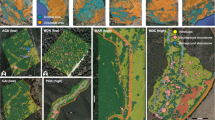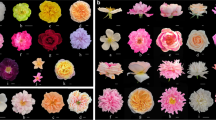Abstract
Poa pratensis L. is a perennial turfgrass with high regeneration and fertility, resistance to cold and drought, and quick colonization. By facultative apomixis, this plant can create a wide range of ploidy levels (2n = 22 to 2n = 154), resulting in a wide range of chromosomal numbers and sexual and apomictic reproductive diversity. The plant materials included fifty accessions from Iran’s Center, South, North, North-East, North-West, and West ecoregions. UPOV standards were used to measure the qualities that were researched. The squash technique of chromosome counting revealed that Iranian Kentucky bluegrass accessions had chromosomal counts ranging from 24 to 87. The relative sizes of the 2C genomes were measured using laser flow cytometry. The range of DNA content was fairly wide, ranging from 4.92 to 11.52 pg. DNA content has a strong positive correlation with elevation, a moderately positive correlation with flag leaf length and leaf sheath width, and a negative correlation with inflorescence anthocyanin color and leaf anthocyanin color. The genotypes and ecological zones of this plant in Iran were distinguished based on morphological diversity and DNA content. The results from this study could be useful in identifying and studying wild Kentucky bluegrass genotypes. It aids in predicting the location of rare genotypes used as breeding materials. It can also increase the plant’s variability for future generations by introducing new ecotypes, with particular genomic and morphological traits, to previously cultivated populations. We expect that the findings of this study will aid in understanding the evolution of this plant in the context of Iran’s climatic variety.





Similar content being viewed by others
References
Soreng, R. J., & Barrie, F. R. (1999). Proposal to conserve the name Poa pratensis (Gramineae) with a conserved type. Taxon, 48(1), 157–159. https://doi.org/10.2307/1224640
Bushman, B. S., Joshi, A., & Johnson, P. G. (2018). Molecular markers improve breeding efficiency in apomictic Poa pratensis L. Agronomy, 8(2), 17. https://doi.org/10.3390/agronomy8020017
Gan, L., Di, R., Chao, Y., Han, L., Chen, X., Wu, C., & Yin, S. (2016). De novo transcriptome analysis for Kentucky Bluegrass dwarf mutants induced by space mutation. PLoS ONE, 11(3), e0151768. https://doi.org/10.1371/journal.pone.0151768
Meyer, W. A., Hoffman, L., & Bonos, S. A. (2017). Breeding cool-season turfgrass cultivars for stress tolerance and sustainability in a changing environment. International Turfgrass Society Research Journal, 13(1), 3–10. https://doi.org/10.2134/itsrj2016.09.0806
Puyang, X., An, M., Han, L., & Zhang, X. (2015). Protective effect of spermidine on salt stress induced oxidative damage in two Kentucky bluegrass (Poa pratensis L.) cultivars. Ecotoxicology and Environmental Safety, 117(1), 96–106. https://doi.org/10.1016/j.ecoenv.2015.03.023
Bashaw, E., & Funk, C. R. (1987). Apomictic grasses. Principles of cultivar development (pp. 40–82). Macmillan.
Huff, D. R., Casler, M., & Duncan, R. (2003). Kentucky bluegrass. Turfgrass biology, genetics, and breeding (pp. 27–38). Wiley.
Zhao, Y., Yu, F., Liu, R., & Dou, Q. (2017). Isolation and characterization of chromosomal markers in Poa pratensis. Molecular Cytogenetics, 10(1), 1–9. https://doi.org/10.1186/s13039-017-0307-7
Cai, H., Yamada, T., & Kole, C. (2013). Genetics, genomics and breeding of forage crops. CRC Press.
Huff, D. R. (2010). Bluegrasses. Fodder crops and amenity grasses (pp. 345–379). Springer.
Raggi, L., Bitocchi, E., Russi, L., Marconi, G., Sharbel, T. F., Veronesi, F., & Albertini, E. (2015). Understanding genetic diversity and population structure of a Poa pratensis worldwide collection through morphological, nuclear and chloroplast diversity analysis. PLoS ONE, 10(4), e0124709. https://doi.org/10.1371/journal.pone.0124709
Pellicer, J., Hidalgo, O., Dodsworth, S., & Leitch, I. J. (2018). Genome size diversity and its impact on the evolution of land plants. Genes, 9(2), 88. https://doi.org/10.3390/genes9020088
Suda, J., Meyerson, L. A., Leitch, I. J., & Pyšek, P. (2015). The hidden side of plant invasions: The role of genome size. New Phytologist, 205(3), 994–1007. https://doi.org/10.1111/nph.13107
Faizullah, L., Morton, J. A., Hersch-Green, E. I., Walczyk, A. M., Leitch, A. R., & Leitch, I. J. (2021). Exploring environmental selection on genome size in angiosperms. Trends in Plant Science. https://doi.org/10.1016/j.tplants.2021.06.001
Castelli, M., Miller, C. H., & Schmidt-Lebuhn, A. N. (2017). Polyploidization and genome size evolution in Australian billy buttons (Craspedia, Asteraceae: Gnaphalieae). International Journal of Plant Sciences, 178(5), 352–361. https://doi.org/10.1086/691460
Zhang, J., Wang, M., Guo, Z., Guan, Y., Guo, Y., & Yan, X. (2019). Variation in ploidy level and genome size of Cynodon dactylon (L.) Pers. along a latitudinal gradient. Folia Geobotanica, 54(3), 267–278. https://doi.org/10.1007/s12224-019-09359-y
Doležel, J., Greilhuber, J., & Suda, J. (2007). Estimation of nuclear DNA content in plants using flow cytometry. Nature Protocols, 2(9), 2233–2244. https://doi.org/10.1038/nprot.2007.310
Eaton, T., Curley, J., Williamson, R., & Jung, G. (2004). Determination of the level of variation in polyploidy among Kentucky bluegrass cultivars by means of flow cytometry. Crop Science, 44(6), 2168–2174. https://doi.org/10.2135/cropsci2004.2168
Grossman, A. Y., Andrade, M. H. M. L., Chaves, A. L. A., Mendes Ferreira, M. T., Techio, V. H., Lopez, Y., Begcy, K., Kenworthy, K. E., & Rios, E. F. (2021). Ploidy Level and genetic parameters for phenotypic traits in bermudagrass (Cynodon spp.) Germplasm. Agronomy, 11(5), 912. https://doi.org/10.3390/agronomy11050912
Speckmann, G., & Van Dijk, G. (1972). Chromosome number and plant morphology in some ecotypes of Poa pratensis L. Euphytica, 21(2), 171–180. https://doi.org/10.1007/BF00036757
Meeks, M., & Chandra, A. (2015). The application of flow cytometry and a thioredoxin-like nuclear gene for breeding Poa arachnifera x Poa pratensis hybrids. Plant Breeding, 134(5), 612–622. https://doi.org/10.1139/g04-102
Murovec, J., Kastelec, D., Vilhar, B., Cop, J., & Bohanec, B. (2009). High variability of nuclear DNA content in cultivars and natural populations of Poa pratensis L. in relation to morphological characters. Acta Biologica Cracoviensia, 51(2), 45–52.
Siljak-Yakovlev, S., Lamy, F., Takvorian, N., Valentin, N., Gouesbet, V., Hennion, F., & Robert, T. (2020). Genome size and chromosome number of ten plant species from Kerguelen Islands. Polar Biology, 43(12), 1985–1999. https://doi.org/10.1007/s00300-020-02755-7
Wieners, R. R., Fei, S.-Z., & Johnson, R. C. (2006). Characterization of a USDA Kentucky bluegrass (Poa pratensis L.) core collection for reproductive mode and DNA content by flow cytometry. Genetic Resources and Crop Evolution, 53(8), 1531–1541. https://doi.org/10.1007/s10722-005-7766-0
Arumuganathan, K., Tallury, S., Fraser, M., Bruneau, A., & Qu, R. (1999). Nuclear DNA content of thirteen turfgrass species by flow cytometry. Crop Science, 39(5), 1518–1521. https://doi.org/10.2135/cropsci1999.3951518x
Kelley, A. M., Johnson, P. G., Waldron, B. L., & Peel, M. D. (2009). A survey of apomixis and ploidy levels among Poa L. (Poaceae) using flow cytometry. Crop Science, 49(4), 1395. https://doi.org/10.2135/cropsci2008.09.0553
Greilhuber, J., & Leitch, I. J. (2013). Genome size and the phenotype. Plant genome diversity (Vol. 2, pp. 323–344). Springer.
Bennett, M. D. (1987). Variation in genomic form in plants and its ecological implications. New Phytologist, 106(s1), 177–200. https://doi.org/10.1111/j.1469-8137.1987.tb04689.x
MacGillivray, C., & Grime, J. (1995). Genome size predicts frost resistance in British herbaceous plants: Implications for rates of vegetation response to global warming. Functional Ecology, 9(2), 320–325. https://doi.org/10.2307/2390580
Poggio, L., Burghardt, A. D., & Hunziker, J. (1989). Nuclear DNA variation in diploid and polyploid taxa of Larrea (Zygophyllaceae). Heredity, 63(3), 321–328. https://doi.org/10.1038/hdy.1989.105
Bennett, M. D. (1976). DNA amount, latitude, and crop plant distribution. Environmental and Experimental Botany, 16(2–3), 93–108. https://doi.org/10.1016/0098-8472(76)90001-0
Bor, N. (1970). Gramineae. In K. H. Rechinger (Ed.), Flora Iranica (p. 30). GrassWorld.
Fard, J. R., Zamani, Z., Moghaddam, M. R. F., & Kafi, M. (2012). Evaluation of genetic diversity among some genotypes of Kentucky bluegrass by RAPD molecular markers. Horticulture, Environment, and Biotechnology, 53(4), 298–303. https://doi.org/10.1007/s13580-012-0120-5
Kavousi, M., Assadi, M., & Nejadsattari, T. (2015). Taxonomic revision of the genus Poa L. in Iran, new additions to Flora Iranica, and a new identification key. Turkish Journal of Botany, 39(1), 105–127. https://doi.org/10.3906/bot-1311-31
(CPVO), C.P.V.O., (2017). Protocol for tests on distinctness, uniformity and stability of Poa pratensis.
UPOV/TG/33/7. (2014). Poa pratensis L. (POAAA_PRA). Retrieved from https://www.upov.int/edocs/tgdocs/en/tg033.pdf.
Costich, D. E., Friebe, B., Sheehan, M. J., Casler, M. D., & Buckler, E. S. (2010). Genome-size variation in switchgrass (Panicum virgatum): Flow cytometry and cytology reveal rampant aneuploidy. The Plant Genome. https://doi.org/10.3835/plantgenome2010.04.0010
Jowkar, A., Kermani, M. J., Kafi, M., Mardi, M., Hoseini, Z. S., & Koobaz, P. (2009). Cytogenetic and flow cytometry analysis of Iranian Rosa spp. Floriculture Ornamental Biotechnology, 3(1), 71–74.
Ghanbari, M. A., Jowkar, A., Salehi, H., & Zarei, M. (2019). Effects of polyploidization on petal characteristics and optical properties of Impatiens walleriana (Hook). Plant Cell, Tissue and Organ Culture, 138(2), 299–310. https://doi.org/10.1007/s11240-019-01625-3
Aubry, C. A., Shoal, R. Z., & Erickson, V. (2005). Grass cultivars: Their origins, development, and use on national forests and grasslands of the Pacific Northwest. US Forest Service, Pacific Northwest Region.
Qiu, Y., Hamernick, S., Ortiz, J. B., & Watkins, E. (2020). DNA content and ploidy estimation of Festuca ovina accessions by flow cytometry. Crop Science, 60(5), 2757–2767. https://doi.org/10.1002/csc2.20229
Gonçalves, T. M., Vigna, B. B. Z., Azevedo, A. L. S., Ferreira, J. R. G., Pozzobon, M. T., & Fávero, A. P. (2021). Reproductive mode and DNA content of Paspalum accessions from Plicatula group: Reproduction and DNA content of Paspalum. Flora, 279(7), 151810. https://doi.org/10.1016/j.flora.2021.151810
Chaves, A. L. A., Carvalho, P. H. M., Ferreira, M. T. M., Benites, F. R. G., & Techio, V. H. (2021). Genomic constitution, allopolyploidy, and evolutionary proposal for Cynodon Rich. based on GISH. Protoplasma, 259, 1–13. https://doi.org/10.1007/s00709-021-01716-z
Dennhardt, L. A., DeKeyser, E. S., Tennefos, S. A., & Travers, S. E. (2016). There is no evidence of geographical patterning among invasive Kentucky bluegrass (Poa pratensis) populations in the northern great plains. Weed Science, 64(3), 409–420. https://doi.org/10.1614/WS-D-15-00169.1
Rayburn, A. L., & Auger, J. (1990). Genome size variation in Zea mays ssp mays adapted to different altitudes. Theoretical and Applied Genetics, 79(4), 470–474. https://doi.org/10.1007/BF00226155
Achigan-Dako, E. G., Fuchs, J., Ahanchede, A., & Blattner, F. R. (2008). Flow cytometric analysis in Lagenaria siceraria (Cucurbitaceae) indicates correlation of genome size with usage types and growing elevation. Plant Systematics and Evolution, 276(1), 9–19. https://doi.org/10.1007/s00606-008-0075-2
Becher, H., Powell, R. F., Brown, M. R., Metherell, C., Pellicer, J., Leitch, I. J., & Twyford, A. D. (2021). The nature of intraspecific and interspecific genome size variation in taxonomically complex eyebrights. Annals of Botany, 128(5), 639–651. https://doi.org/10.1093/aob/mcab102
de Campos, J. M. S., Sousa, S. M., Silva, P. S., Pinheiro, L. C., Sampaio, F., & Viccini, L. F. (2011). Chromosome numbers and DNA C values in the genus Lippia (Verbenaceae). Plant Systematics and Evolution, 291(1), 133–140. https://doi.org/10.1007/s00606-010-0370-6
Bonos, S. A., Plumley, K. A., & Meyer, W. A. (2002). Ploidy determination in Agrostis using flow cytometry and morphological traits. Crop Science, 42(1), 192–196. https://doi.org/10.2135/cropsci2002.1920
Wang, Y., Bigelow, C. A., & Jiang, Y. (2009). Ploidy level and DNA content of perennial ryegrass germplasm as determined by flow cytometry. HortScience, 44(7), 2049–2052. https://doi.org/10.21273/HORTSCI.44.7.2049
Yan, J., Zhang, J., Sun, K., Chang, D., Bai, S., Shen, Y., Huang, L., Zhang, J., Zhang, Y., & Dong, Y. (2016). Ploidy level and DNA content of Erianthus arundinaceus as determined by flow cytometry and the association with biological characteristics. PLoS ONE, 11(3), e0151948. https://doi.org/10.1371/journal.pone.0151948
Clayton, W., Vorontsova, M., Harman, K., & Williamson, H. (2016). GrassBase-the online world grass flora. GrassBase-The Online World Grass Flora. Retrieved from http://www.kew.org/data/grasses-db.html.
Gallaher, T. J., Adams, D. C., Attigala, L., Burke, S. V., Craine, J. M., Duvall, M. R., Klahs, P. C., Sherratt, E., Wysocki, W. P., & Clark, L. G. (2019). Leaf shape and size track habitat transitions across forest–grassland boundaries in the grass family (Poaceae). Evolution, 73(5), 927–946. https://doi.org/10.1111/evo.13722
D’Ario, M., Tavares, R., Schiessl, K., Desvoyes, B., Gutierrez, C., Howard, M., & Sablowski, R. (2021). Cell size controlled in plants using DNA content as an internal scale. Science, 372(6547), 1176–1181. https://doi.org/10.1126/science.abb4348
Funding
This work received support from Shiraz University.
Author information
Authors and Affiliations
Corresponding author
Ethics declarations
Conflict of interest
The authors declare that they have no conflict of interest.
Additional information
Publisher's Note
Springer Nature remains neutral with regard to jurisdictional claims in published maps and institutional affiliations.
Rights and permissions
About this article
Cite this article
Ghanbari, M.A., Salehi, H. & Jowkar, A. Genetic Diversity Assessment of Iranian Kentucky Bluegrass Accessions: II. Nuclear DNA Content and Its Association with Morphological and Geographical Features. Mol Biotechnol 65, 84–96 (2023). https://doi.org/10.1007/s12033-022-00534-9
Received:
Accepted:
Published:
Issue Date:
DOI: https://doi.org/10.1007/s12033-022-00534-9




